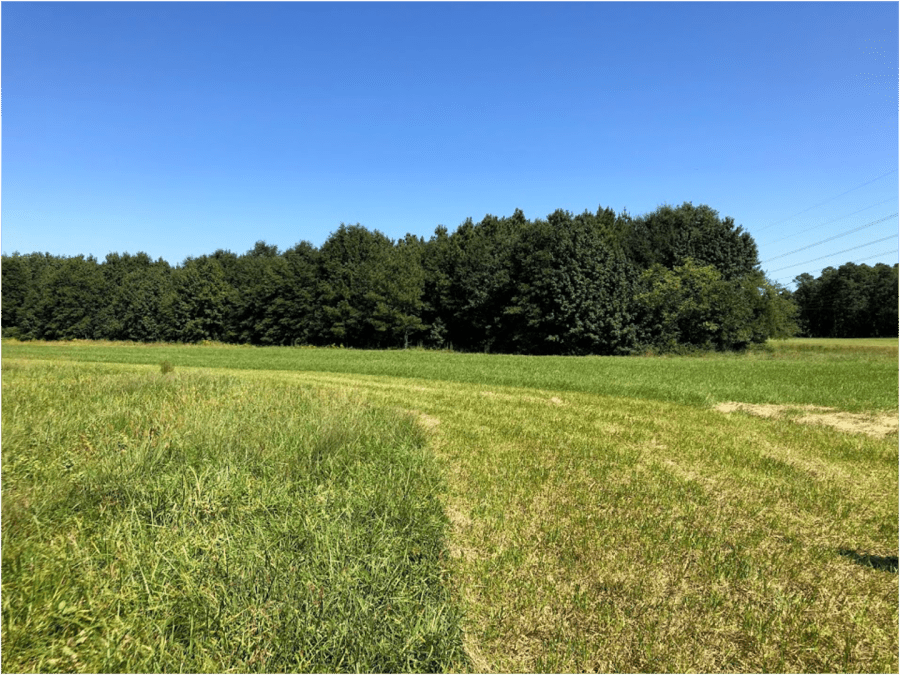RICHMOND, VA – Capital Region Land Conservancy (CRLC) has recorded their latest in a series of conservation easements focused on protecting agricultural resources and livelihoods in the Richmond region. Working with CRLC and Henricopolis Soil and Water Conservation District as co-holders of the easement, Doug Godsey of Godsey Properties Inc. officially preserved 124.314 acres of privately-owned land in Henrico County, much of which is working farmland, thereby removing it from the crosshairs of development. Located on Kingsland, Hoke Brady, and Varina Roads in Henrico County, the new CRLC easement supports the goals of the Henrico County Comprehensive Plan and contains provisions to preserve the property’s multi-faceted conservation values, which include approximately 90 acres of priority agricultural lands as well as 30 acres of freshwater wetlands, and historically important battlefields adjacent to the Richmond National Battlefield Park.
The move to preserve this property stands in stark contrast to the rising pressure to develop agricultural land across the state, driven most recently by shifts in COVID-era lifestyles and soaring housing prices. Especially noteworthy is the care the easement takes to preserve the agricultural value of the land and at the same time honor the working relationship between the landowner and Charlie Purks, whose family was the prior owner and who continues to farm the land. The easement facilitates the implementation of conservation practices that preserve the land’s prime agricultural soils for future generations while protecting the purpose of this contractual relationship.
According to a survey by the American Farmland Trust, the type of working relationship exemplified by Mr. Godsey and Mr. Purks is a common but seldom broadcast trend in agriculture. Whereas the general cultural consciousness may assume that a farmer cultivating the land also owns the land, this turns out to be just one possible arrangement. Alternatively, it is not infrequent for a landowner to rent out his or her land to be cultivated by an experienced farmer, who may then hire additional hands. These types of contracts between “non-operator landowners” (NOLs) and their “operators” are instrumental to implementing sustainable farming practices and advancing food security in our region.
“I have a deep belief that non-operator landowners like myself are only part of the equation,” said Doug Godsey. “To be an effective steward of my land, it is crucial to work closely with Mr. Purks as we develop a sustainable future for the land’s soil and crops. Part of that process is understanding Mr. Purks’s needs and goals, so that our contract can reflect his perspective.”
Despite the importance of these working relationships, the conservation community has relatively little awareness of the perspectives and needs of NOLs and operators. This presents a challenge for policy makers, natural resource agencies, and conservation groups to understand how best to work with NOLs to achieve more effective resource management of the lands they rent to their operators. NOLs are also key to facilitating greater access to farmland.
“Land is expensive, and owning it adds an expensive burden on top of an already expensive business. I don’t know exactly how many would-be farmers are kept off the land due to issues of cost and access, but I see the type of relationship I have with Mr. Godsey as a partial solution to get more farmers working the land and cultivating a better future for our region and our state,” said Mr. Purks.
The expense and burden of accessing farmland in Virginia is due in part to the alarming rate of farmland conversion occurring in our state and nationwide. According the American Farmland Trust’s report “Farms Under Threat,” more than 339,000 acres of farmland were developed in Virginia between 2001 and 2016. Of this, eighty percent (80%) was converted to low-density residential development. In the Richmond region, specifically, more than 87,000 acres of farmland have been lost since 1982, and Henrico County’s percentage of land area for agriculture decreased from more than 18% to 5% with fewer than 100 farms and 10,000 acres of farmland recorded in the 2017 U.S. Agricultural Census.
While this startling loss of farmland in our Commonwealth clearly threatens our agriculture and our food system, other conservation values that are often intertwined with agricultural lands also come under threat. Mr. Godsey’s property, for example, is considered historically important due to its role as a battlefield or staging area for the Civil War battles of Second Deep Bottom and Chaffin’s Farm, both of which heavily involved The United States Colored Troops (USCT) and led to the ultimate cessation of war in Appomattox. The property has been identified by the American Battlefield Protection Program to be among the most intact and threatened historical battlefields in Virginia. Preserving the property ensures that these battlefields and the Americans who fought upon them will not simply be forgotten.
“Conservation is rarely about protecting one thing. In the case of this easement, Mr. Godsey is helping to protect not only our region’s agricultural viability, but also our cultural identity and our sense of history,” said CRLC’s Executive Director, Parker Agelasto. “From battlefields to fields of corn, our region’s landscapes deserve a conservation approach that is as multi-faceted as the land itself.”
“It is a great honor to participate in a process that protects water quality, soil fertility, air quality, habitat, view sheds, and the open space on which Virginia’s agriculture, forestry and tourism industries depend; not just today, but for future generations,” said Nicole Anderson-Ellis, Chair of the Henricopolis Soil & Water Conservation District Board of Directors.

